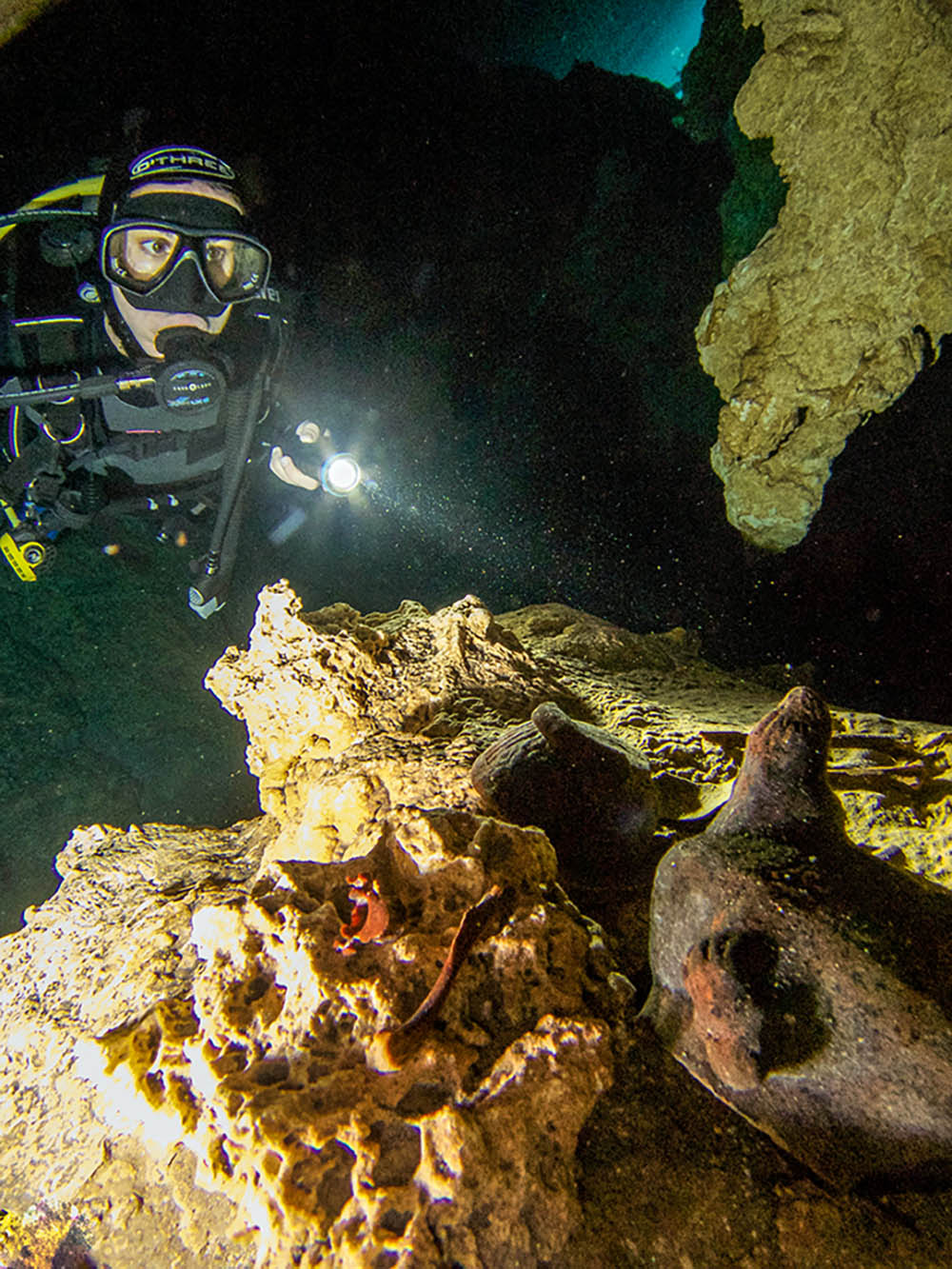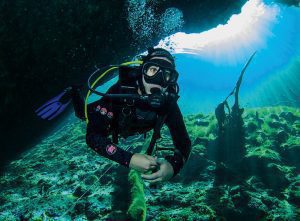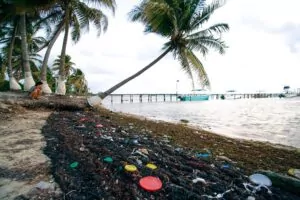MEXICO DIVER
On The Road In Yucatan
Twelve days in Mexico around Christmas – perfect for some iconic caverns with Mayan relics, bull sharks and classic reefs, reasoned will appleyard. Shame about taking that wrong turn when he landed at the airport…

Mayan pottery in what at the time was still called Dos Ojos cenote.
Appeared in DIVER April 2018
POSSIBLY WITH THE PERSUASION of a few pesos, the police allow our “taxi-driver” to carry on with his fare. They have just discovered drugs in the boot of the car, and have also revealed to us that the guy is not in fact a licensed cabbie at all.
We had arrived at Mexico’s Yucatan peninsula, a 70,000sq-mile carpet of jungle and by all accounts a treasure-trove of diving opportunities. A dive-trip here needs some consideration should you wish to experience all the good stuff in a reasonably short space of time.
We wanted to see as much as we could in 12 days and had come up with what we thought was a fulfilling itinerary.
Tired and wired after the flight from Gatwick, we had been duped at Cancun airport by some bogus chaps posing as officials, and should have been driving our own hire-car by now.
 Instead, we were on our way to Tulum in a pricey taxi that we had been conned into taking. We should have been a little savvier but, hey, adventure isn’t adventure unless something goes wrong .
Instead, we were on our way to Tulum in a pricey taxi that we had been conned into taking. We should have been a little savvier but, hey, adventure isn’t adventure unless something goes wrong .
For this style of diving road-trip a hire-car is essential. It will assist you in the discovery of some of the more remote, tourist-free dive-spots – along with some of the busier ones.
Tulum is just under two hours’ drive south of Cancun, and is the first place to head to on this tour. It then takes you further south to the village of Xcalak and eventually leads you back up north and on to Playa del Carmen and Cozumel, where the adventure will wind down.
The town of Tulum is home to some of the most enchanting, exciting, adventurous and unique diving you’re ever likely to experience, not to mention some great places to hang out après-dive.
It’s all about cenote-diving here, but you don’t have to be cave- or cavern-trained to be part of the action. If you’re thinking: “Overhead diving isn’t for me”, stay tuned, because not all the cenotes involve an overhead diving environment.
Four days is a good amount of time to take in a great selection of cenotes. Knowing very little about the diving set-up here, we chose to dive and stay with Underworld Tulum, a dive-centre that comes complete with onsite self-catering apartments, and run and owned by British cave-diving instructors Lanny and Claire Vogel.
I believe there are two reasons for choosing to dive with a British operation where cenote diving is concerned; firstly, there is a certain amount of reassurance when it comes to safety and, secondly, you are less likely to be seen as a walking wallet among a conveyor-belt of other diving tourists.
I would never assume that other diving operations in Tulum wouldn’t take care of you, but reputation goes a long way and, with just four days in which to explore, we wanted peace of mind.
El Pit would be the first of four cenotes we were to dive. They all have great names and the Pit is of that sort where you can pretty much avoid anything overhead while diving. It’s no shakedown dive, however, being fairly deep.
The entrance resembles an azure pond, and I wonder what the first underwater explorers had thought as they slipped beneath the surface, as we did, to discover not a pond but a 30m-plus deep chasm. This becomes a massive cathedral of light, with sheer walls and impressive rock formations.
Although the gnarly captain cave-divers all seem to dive drysuits in Tulum, a 3mm full-length wetsuit is all you need because here the water temperature is 25°C. A thin hood is worth taking too.
THE WORD CENOTE is derived from the Mayan word D’zonot and refers to what forms where a cave ceiling has collapsed. The systems are formed over millions of years by the gradual dissolving by slightly acidic rainfall of highly porous limestone.
Inside the once-dry caves stalactites and stalagmites formed and today, now filled with water, they draw cave- and cavern-divers from all over the world.
I mentioned feeling like a walking wallet in Mexico, one example being that I am required to pay to take a camera along on some of my dives – up to a tenner a time.
The cenotes mainly sit on private land, and the landowner naturally wants to make a buck or two. If, unlike me, you have a small camera set-up without strobes, you might be able to stash it in a BC pocket, if you know what I mean.
During our four-day underworld tour, Lanny drives us from cenote to cenote in his pick-up, the motor of choice for this pursuit. Many cenotes lie very close to one another, and day two finds us at what was until recently Dos Ojos (Two Eyes).
Dos Ojos had just been joined up by explorers from the Great Maya Aquifer Project (GAM) to the Sac Actun system, making it the longest-known underwater cave system in the world at 347km (see News, March).
Just embarking on a cavern-dive at the former Dos Ojos you’re in an overhead environment, with two permanent lines marking out two main cavern routes.
But shards of light pour in at some points, and in one area it’s possible to surface in a bat-cave, complete with bats. This, I’m told, is a cenote waiting to happen, and cars have stopped parking on its roof for obvious reasons. Otherwise, one day it could be a wreck-site too.
Dive-sites don’t come any more bizarre than the Angelita cenote. It’s famed for its spooky layer of green hydrogen sulphide gas 30m down. We spend the morning here, and on reaching the gas layer can’t resist dropping through it into the pitch-black, saline layer of water below.
Caused by decomposing plant matter and combining with some slight narcosis, this 3m-thick layer provides the backdrop for a dive like nothing else, save for perhaps a very weird dream.
It’s possible to spice things up further by venturing to the very bottom at 57m, but I think I’ll save that one for another day.
WE WRAP THE TULUM part of this tour up by checking out the cavern-diving at the Car Wash cenote, named because local taxi-drivers used to wash their cabs there. This is probably one of the prettiest dive-spots in the area, and known for having easily viewed Mayan pottery remains.
This mild overhead-environment dive is one of the tamer of the four sites we visit, but whatever the difficulty level, good buoyancy control is paramount for visiting divers.
We leave Tulum feeling that we could have stayed for at least another four days, but Xcalak is calling. Pronounced ish-ca-lak, it has been described as one of the “last unspoiled stretches of the Mexican Caribbean”. It takes about three hours to drive south to Xcalak from Tulum along an endless straight road that slices through the jungle and passes through only a few towns.

The village, blasted by hurricanes from time to time, boasts only 375 inhabitants and is home to the XTC dive-centre. Like Underworld, XTC offers accommodation, and our room sits right on the beach.
Ana and I see only five or six other divers during our stay, so we feel we have exclusive access to some of the most pristine canyon and soft-coral diving I have seen.
Manatees live here too, along with tarpon, a fish I haven’t come across before and which tend to be about a metre in length here.
The canyons stretch like rocky fingers from shallower water and away into the blue on a setting of white sand. Soft corals, fans and hard corals drape the rock, and you would be hard pressed to find any sign of diver damage here.
Our cut-off depth is 27m as we work our way up to shallower water over the course of an hour set aside for each dive. It can be a bit of a breezy place topside, so leaving the water can be a mission if you’re not used to that kind of caper.
Xcalak is a sleepy place with nothing more to do than hang out in a hammock, dive, sleep, eat and repeat. If you’re unable to function without a buzzing town, it isn’t for you. If you want to escape the crowds, you’ll be in divers’ paradise.
Ideal as that all sounds, the beaches of Xcalak come with a problem common to many areas of the world’s coastline today – plastic – and quite a lot of it.
Sad times.
Three nights and two days diving in Xcalak is perfect for us, and if the weather is playing ball you can invest in a dive trip over at Banco Chinchorro, the northern hemisphere’s largest atoll.
Unfortunately it’s too windy for us to make the two-hour boat journey.
THE NEXT PART OF THE TOUR is mainly set aside as a driving day, broken up with a Mayan ruin stop-off or two along the way to the next destination, Playa del Carmen. You’ll need about four hours of car time, driving north again and passing Tulum once more on the way.
Topside, Playa del Carmen is not my kind of place at all, heaving with tourists, bursting with hotels and with endless opportunities to spend your pesos along a strip of noisy bars, shops and restaurants, but it’s great for some, I guess.
The reason for being here in December is that it’s bull-shark season and that lasts for only about three weeks, the pregnant females gathering just 250m off the main beach over a 26m seabed.
It’s no secret that the sharks are here, and although it’s easy to grumble about having a bunch of other divers beside you, I think we’d all prefer the sharks to be generating tourist money than being fished out of existence.
DURING THIS SHORT SEASON the sharks are protected from fishing, and the males hang out further up-country. It’s fabulous to see these big sharks at close quarters although, as with any animal encounter, nothing is guaranteed. We see perhaps three sharks in total, whereas on other days we might have seen many more than that and close enough to photograph properly.
The shark trip is usually a one-dive experience unless you want to marry it up with a second local reef for a few bucks more, but we recommend investing in the shark trip, ditching the hire-car and heading off on the passenger ferry from Playa del Carmen to Mexican dive-destination favourite Cozumel.
I have been told that there are more than 100 dive-centres on Cozumel Island, and as we leave the marina on the morning of our two-tank dive-day, I can believe it. The scene at sea puts me in mind of the D-Day landings, with more dive-boats on the water than you could shake an SMB at.
We choose quite randomly, and out of laziness, to dive with a centre near our hotel called Studio Blue. It’s a bit of a gamble, because we’re visiting at the busiest time of year – Christmas.
The other divers on Studio Blue’s boat are a mix of holidaying Mexicans and Americans, and we’re heading to one of the many sites that run along Cozumel’s west coast. We had checked out the windward side the previous day on a scooter, and it was howling.
After spending many days in the summer humping my gear on and off UK dive-boats, it’s great to be made a fuss of when diving abroad. Studio Blue does just that. Dive-guides are everywhere, handing me my weights and camera, fitting my wing, rinsing masks – pure bliss!
Leaving the surface as part of a group of five, we make straight for the drop-off and wind our way into some very impressive swim-throughs. The scene inside many of them is a bit “diver-worn”, with broken coral visible in many places, and the groups ahead of us look as if they might have contributed to the breakages.
The soft and hard corals here are spectacular, however, with species I haven’t seen before. I’m in the right place at the right time for a hawksbill turtle to cruise past my camera lens, and although we have been briefed that every dive off Cozumel should be considered a drift-dive, the current is minimal.
Save for perhaps some Red Sea sites in high season, Cozumel is one of the busiest places I have dived, but it’s busy for good reason – scenically, it’s outstanding.
Photographers would do well to do more research than me and look into dive-centres dedicated to their needs, and I’m sure there are plenty on the island.
I FELT SLIGHTLY HURRIED through the dive towards the safety stop, but it’s enjoyable for all that.
I think our guide, a lovely lass, recognises my desire to slow the pace when it comes to dive two, which is shallower by a few metres than our first 20m dive, and with far fewer people in the water.
The clarity of the water is off the chart around Cozumel, and the sand so white that it looks like an over-exposed photo.
Great lumps of rock and coral provide shelter for a healthy population of fish as well as moray eels at regular intervals – it’s a beautiful place to be.
I would never dive without an SMB, but I strongly advise that you dive with your own here, because as you break the surface you don’t know what will be heading towards you.
In fact you do. Jet-skiers weave in and out of the scores of dive-boats, so should you for whatever reason become separated from your group and surface alone, you’ll be taking an almighty risk by popping your head up without having a marker buoy to wave about.
There’s big stuff to enjoy around Cozumel, too, but if you’re after whale sharks May to September is your season – you won’t find them if you’re following our Christmas itinerary.
By the time you reach the end of this 12-day tour, the Yucatan will have furnished you with some of its best diving offerings. You’ll be pining to come back, I promise, and if you’re anything like me, you’ll be seriously considering enrolling on a cave-diving course.
FACTFILE
GETTING THERE> Will Appleyard flew with Air Europa from London Gatwick to Cancun, aireuropa.com. Car hire: Mex Rent A Car, mexrentacar.com
DIVING & ACCOMMODATION> Underworld Tulum, facebook.com/underworldtulum. XTC Dive Centre (Xcalak), xtcdivecenter.com. Tank Ha (Playa del Carmen), tankha.com. Mary Carmen Hotel (Cozumel), hotelmarycarmen.com.mx. Studio Blue (Cozumel), studiobluecozumel.com
WHEN TO GO> Bull-shark season is December-March, hurricane season is July-October.
MONEY> Mexican peso, US dollars.
PRICES> Will’s flight cost £770. The car cost £225 for seven days (it wasn’t needed until after Tulum) from Mex Rent A Car. Two-dive cenote day with equipment, nitrox & lunch with Underwater Tulum, US $170; two-tank boat dive with XTC $125, Studio Blue, $87; one bull-shark boat-dive with Tank Ha, $110. Self-catering apartment at Underwater Tulum, $85 per night, room only at XTC $50 and Mary Carmen Hotel $55 per night (all two-sharing).
VISITOR INFORMATION> visitmexico.com
